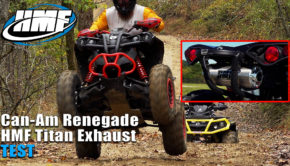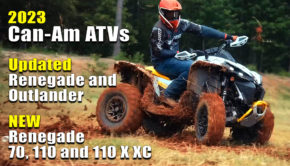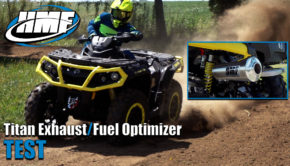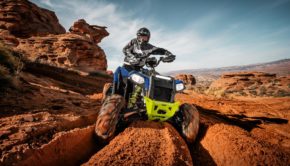Published on June 1st, 2019 | by Joe
2019 Can-Am Outlander 1000R XT-P Test: WITH VIDEO
Cam-Am Outlander 1000R XT-P Ratings
Summary: Can-Am’s chassis and suspension updates have made a huge step forward when it comes to handling. Can-Am’s new wider, more stable chassis lets you better harness the engine’s over the top power. The three mode, intelligent throttle control system makes the 1000R more manageable at lower speeds without dumbing down the performance when you’re trying to access all the thrilling power, acceleration, and responsiveness that most riders are looking for from a one liter machine. Can-Am has the most improved 4x4 ATV line and 4x4 ATV of 2019 with the Outlander 1000R
4.2
6 Month Test
Better handling and more power top the list of changes to the most improved ATV of 2019
For 2019, Can-Am has made a number of very significant updates to their Outlander ATV lineup including wider track widths, updated suspension, and much, much more. Receiving the largest number of updates and features is the incredibly hard-working, race winning, Outlander 1000R, which, once again, tops the power wars at a claimed 91 horsepower.
Can-Am offers many different trim packages on the Outlander 1000R including the DPS, XT, and Mossy Oak Hunting Edition. The X-XC model comes outfitted for cross country racing from the factory, while the X-MR model is purpose-built for mud riders. Finally, there’s our test unit, the Outlander 1000R XT-P. Its laundry list of factory features reads like a project build for the ultimate ATV to work hard and play even harder. It’s the type of ATV that begs you to blaze a trail, and then see how fast you can ride it. The Outlander 1000R XT-P features heavy-duty front and rear steel bumpers, 3,000 Warn winch, 14” beadlock wheels and similar handguards to the X-XC package. FOX Podium 1.5 QS3 shocks bridge the gap between high-performance and easy adjustability for varying uses. The Outlander 1000R XT-P is a real top of the line dream machine and the perfect way to experience all the exciting changes Can-Am has brought to the Outlander 1000R for 2019 and beyond.
Engine
The 1000R is powered by a water-cooled, fuel-injected, 976cc, V-twin, four-stroke engine with four valves and SOHC per cylinder. The automatic CVT transmission features high and low ranges, plus neutral, reverse, and park, selected by a gated shifter. Engine braking comes standard.
Available with the use of premium pump gas, 2019’s jump from 89 to 91 horsepower is due to the addition of a knock sensor, which automatically optimizes ignition timing to match varying fuel quality. You can run as little as 87 octane, which we don’t recommend as pump gas octane level decreases rapidly with little age.
The rear differential is claimed to now be a whopping 50% stronger thanks to an increase in size from 143mm to 155mm.
A right side, handlebar mounted switch selects between two and four-wheel-drive featuring Can-Am’s Visco-Loc QE, auto-locking front differential, which operates as a limited slip front end, progressively locking in full four-wheel-drive if the front end begins to slip. It then unlocks when traction has been restored. Can-Am recommends switching between drive modes while stopped with the engine at idle.
With the throttle cable replaced with a throttle by wire system, Can-Am is introducing their Intelligent Throttle Control on the 1000. A push button toggle switch on the throttle allows you to select between three throttle modes, work, normal, and sport. Work mode reduces top speed to 43 mph spread across the entire throw of the throttle, allowing for easier throttle modulation. Normal mode is designed to deliver full throttle with smooth initial throttle delivery. Sport mode is designed to deliver snappier, more immediate throttle delivery with less throttle lever movement needed. Intelligent throttle control is also designed to filter out unwanted throttle inputs from rough terrain.
Starting the engine requires the use of Can-Am’s Digitally Encoded Security System keys. It comes with a green and a gray one. The Green Key limits top speed to 43 mph for workers or newer riders.
With the DESS Key attached, the Outlander comes to life with a push of the start button, emitting a pleasant, quiet rumbling at lower RPMs that’s non offensive for a long day’s work. Open it up, and the exhaust emits a reasonably quiet, but very sporty sounding roar.
Ample horsepower and torque are available at all RPMs. Clutch engagement is very snappy and responsive both off the line and accelerating at speed. Even with the throttle setting in work mode, the clutch still provides some snap off the line. That’s helpful for work and play, but potentially a bit intimidating for riders who probably shouldn’t be riding this much machine anyway.
When discussing power, we have to talk about the throttle. No one loved its design. It’s too smooth for some; its shape drew unanimous complaints, although its light action drew praise. Its electronic function is excellent. The throttle’s work mode really mellows out the power and filters abrupt, unwanted input from the rider from traversing bumps for working or technical riding when maximum throttle control is of benefit. Normal mode provides full throttle wide-open, with smooth delivery off the bottom and, seemingly, a good amount of filtration for unwanted throttle inputs from bumps. There isn’t much feeling of lag, unless you make an abrupt demand. Sport mode delivers more throttle sooner in the throttle throw with crisp, precise throttle response. All settings are beneficial depending on the terrain and use.
Sport mode provides the most direct throttle feel, with virtually zero detectable lag when you punch the gas at any RPM. The more directly connected feeling lets you appreciate just how insanely powerful the big Rotax V-twin really is. Regardless of your current speed, load, or the steepness of the terrain directly in front of you, the engine feels unaffected and is always willing to build RPMs in a hurry. The CVT’s responsiveness only adds to the thrills with a bit of snap when it engages launching you out of the hole or tight corners. Lag is not an issue getting in and out of corners at speed either. The sporty, responsive nature of the engine and transmission lend themselves to jumping, wheelies, or cracking the throttle to get you out of trouble if needed. It’s also beneficial when getting a heavy load moving. As sport/utility ATV engines go, nothing is faster or more thrilling to ride than the Outlander 1000R.
This is the second Can-Am ATV we’ve tested with their Visco-Loc QE four-wheel-drive system. Its performance is far more impressive than their original Visco-Loc front differential, locking in both front wheels much more quickly when needed. Some may still demand a manually lockable front differential, but we’ve been very happy with its performance thus far.
Engine braking struck a good balance between aiding in keeping speeds under control at lower speeds, or while working, without feeling like you dropped anchor when chopping the throttle at speed.
Handling and Suspension
Can-Am claims to have delivered the industries’ best handling, stability, and comfort across the Outlander 650, 850, and 1000 line with its brand new suspension. Can-Am had made a number of changes to their SST frame over the years to improve its durability and handling characteristics. For 2019, the Outlander now sits 2” wider at 48” wide, thanks to new, 1” longer, arched A-Arms and longer and wider TTI rear arms. This was accomplished without raising the machine’s center of gravity, retaining an overall height of 49.5” and 11” of ground clearance. The frame received minor changes to complement the ATV’s wider stance.
The front A-Arms have been completely redesigned with their wide-arc design offering an additional 1.4” of ground clearance at the mid-point with 11.6” of clearance. This was accompanied by redesigned front axle protectors.
In search of even greater stability, a new front sway bar was added measuring 13.5mm in diameter. This is said to have allowed for the use of a softer rear sway bar helping provide greater rear wheel independence aiding ride comfort.
Taking advantage of the updated chassis required updated shock settings. The longer control arms have allowed for 2/10” more wheel travel up front at 9.2” and 6/10” more travel out back with 9.9”–– very comparable to its main rival the Polaris Sportsman 1000.
Five-way preload adjustable shocks are found on most models with the XT-P’s Fox Podium 1.5 QS3 shocks benefiting from the addition of threaded preload adjustment for easier, more precise adjustments. Piggyback reservoirs add cooling, reducing fade and allow convenient, simple to use, 3-way compression damping adjustment for greater comfort, or faster, more sport focused riding, or while hauling a load. Compared to the DPS and XT models, the XT-P and even more adjustable X-XC model’s Fox shocks feature slightly firmer base settings due to their more sport focused intentions.
Adjustments come in threes on the Outlander XT-P. Can-Am’s Tri-Mode Dynamic power steering lets you choose between three levels of power steering assistance, all of which offer more assistance at lower speeds or when the rider or terrain are putting greater demand on the steering.
Most Outlander 1000 models come outfitted with premium 6-ply, 26×8-14 front and 26×10-14 rear ITP Terracross tires, designed for all-conditions. 14” beadlock wheels used on the XT-P and X-XC models let you ride harder and ensure you can make it back to camp even on a flat.
The Outlander 1000R has a claimed dry weight of 826lbs. It features a claimed 11” of ground clearance, is 49.5” tall with a seat height of 34.5”. It’s now claimed to be 4/10” wider than the Polaris Sportsman 1000 at 48” wide. Its wheelbase is 2” shorter at 51”.
Suspension action is forgiving enough to ride all day, but definitely firm enough for some aggressive sport riding. For most trail riding, even our heavier riders preferred the shocks’ compression damping in its softest setting, which allowed the tires to track better with smaller bumps. Even still, the suspension was stiff enough for all but the largest hits. We switched to the compression damping’s middle setting when we started jumping, which offered all the control needed to keep from bottoming harshly from a few feet of air. We have a feeling that a little less spring preload and running compression in the middle setting will wind up being the hot setup for the trail. We’ll fine tune the suspension a bit more as we continue with our 1000cc shootout.
Rated to haul 100lbs front and 200lbs rear on its racks, we loaded them down with 120lbs of concrete front and 220lbs rear and went for a spin. Without touching preload, we ran the compression in the middle setting, which proved to offer plenty of bottoming resistance traversing deep ruts. The combination of the wider stance, shocks’ spring rates, damping, and front and rear sway bars kept the machine predictably stable on off-cambers despite our slightly overloading it.
For typical riding, while there may be a small trade off in overall plushness on uneven bumps, we applaud Can-Am’s decision to add a front sway bar, while softening up the sway bar out back. The 1000’s added width and dual sway bars allow you to rail corners hooked up and tackle off-cambers with less body roll than you might expect from a big 4×4. For 2019, handling is far more confidence inspiring than in years past.
While very accurate at low to intermediate speeds, Aaron and Evan both felt that the front end started pushing a bit when charging turns with the back end hooked up. In slick or loamy turns where you can easily steer with the back end, this isn’t an issue. Rob, who is accustomed to sliding three wheelers through high traction turns, was backing the Outlander into every corner, leaving him with zero issues as steering goes.
Steering feel was good. Aaron did notice a slight ratcheting sensation in the power steering near full lock when changing direction quickly at lower speeds, but nothing alarming. The differences between the power steering modes is small but noticeable. Our riders typically used the mid and max settings depending on conditions, although most felt that they could simply leave it in the max setting and be satisfied. It works well without leaving you feeling disconnected from the trail, making it one of our favorite power steering systems on the market.
Our test riders unanimously praised the incredible traction provided by the ITP Terracross tires. They worked well on hard pack, outstandingly in loamy or tacky conditions, with good tread depth and clean out when the trail gets a bit muddy. When they wear out, we’d happily consider sticking with them for general use or even cross country racing.
Brakes
Up front stopping power is provided by dual hydraulic disc brakes with 214mm rotors and dual-piston calipers. A similarly appointed single hydraulic disc brake is used out back, all using steel braided brake lines. A left side handlebar mounted lever activated the brakes at both ends with a right-side brake pedal operating the rear brake independently. Steel braided brake lines are standard equipment.
Braking power and feel were both praised by our test riders. Braking is a bit biased toward the front as you would want. The rear brake pedal’s position is close enough to the peg although its position comes a bit high. There’s also a handlebar mounted parking brake that’s easy to engage.
Work Capability
With its full-size, two-inch, reinforced hitch receiver and beefed up drive line, the Outlander line is rated to tow a class leading 1,650 pounds.
The composite racks are rated to haul up to 100lbs front and 200lbs rear. They feature Can-Am’s LinQ quick attachment points for Can-Am accessories. A rubberized surface is designed to help keep cargo from slipping around. Out back, there’s a 5.7 gal dry storage box.
While we typically whine about how much we prefer steel racks, the rubberized racks on the Outlander actually do a good job of helping keep items in place. We also found the racks to offer a decent number of tie-down points that we felt pretty good about cinching down on. If we still prefer steel racks, the Outlanders have our favorite composite racks on the market.
We like that Can-Am’s storage box can be accessed even with the racks loaded down, something you can’t do with the slightly more spacious storage on the Polaris.
Fit and Finish
The cockpit is well appointed for the Outlander’s various intentions. The midsection is comfortably slim compared to the overall stature of the machine. The seat is plush and easy to move around on, although Aaron and Evan both wished it was slightly lower when riding aggressively. The floorboard area is spacious enough and features raised plastic pegs. We wouldn’t mind a slightly taller peg for snow or muddy conditions.
A superb, redesigned digital and analog instrument display is mounted “in front of” instead of “on top of” the handlebars unlike most 4×4 ATVs. This makes it easy to outfit the Outlander with any type of aftermarket handlebar style or bend you prefer. The sport quad style, tapered, stock aluminum handlebars add to the machine’s racy feel along with the sport style, wrap around, handguards.
Dual 60 watt projectors and 55 watt reflector headlights offer 230 watts of power. They do well at illuminating the trail at night. Tail and brake lights are found out back.
Compared to the very similar performing Renegade, the Outlander enjoys a higher level of splash protection that we strongly value out on the trail.
Conclusion
While this definitely isn’t a price point driven class, it’s worth noting that the Outlander 1000R DPS and XT models deliver more features for a bit less money than the competition’s closest equivalents.
The XT-P package we tested along with the X-XC model are beyond anything currently offered by other manufacturers in the sport/utility segment. You’ll spend more money on any other ATV trying to create an equivalent of the XT-P or X-XC models as they come from the factory.
Can-Am’s chassis and suspension updates have made a huge step forward when it comes to handling for the Outlander lineup. While machines in the 1000 class are a bit overpowered for general trail riding or most work applications, Can-Am’s new wider, more stable chassis lets you better harness the engine’s over the top power.
The three mode, intelligent throttle control system makes the 1000R more manageable in lower speed, or technical situations, without dumbing down the performance when you’re trying to access all the thrilling power, acceleration, and responsiveness that most riders are looking for from a one liter machine.
Can-Am’s 2019 updates were exactly what was needed to have Outlander riders riding faster with greater control and confidence, and farther with enhanced comfort. Can-Am’s ATV lineup is easily the most improved of 2019 and sets a standard for refinement that we hope other manufacturers will follow into 2020.




